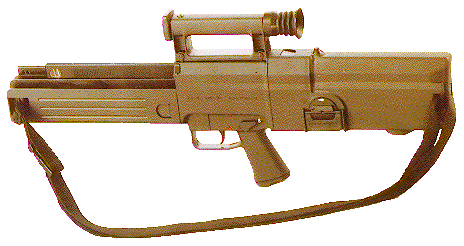Heckler & Koch G11 [Automatic Rifle]:

The H&K G11 is part of the "Family of Caseless Weapons." Development of caseless bullets began about 25 years ago, but it was not until 1988 that final troop and technical tests of the G11 caseless ammunition rifle were carried out by the West German Army.
It was evaluated against the G3 rifle and underwent a series of gruelling tests. The manufactures were so confident of the robustness of the rifle and its optics that they provided a simple 1:1 optical sight (designed for realistic combat ranges up to 300 metres) without backup iron sights. (Later rifles carried emergency plastic sights moulded onto the rifle itself as well as design allowances for night-vision scopes and other such accessories)
After the troop testing, many improvements were made, not the least of which was the redesign of the handguard and receiver to accomodate three 45-round magazines to be carried on the rifle. Despite carrying 135 rounds in fully loaded magazines, the rifle would still weigh less than an empty M1 Garand! These improvements, such as the magazine carrying capacity, new sights, and the ability to carry a bayonet, laser pointer, or bipod, are part of the new K2 version of the rifle.
It appears as if the G11 was to become quite a success. The G11 (K2 model) was found to be more quickly and easily learned by new recruits during the German Army testing of the rifle in the Fall of 1989. The unorthodox shape and operating procedures of rifle allowed the new draftees to achieve an average of 50% more hits using the G11 compared to the results with the G3 rifle.
In 1990, the German Army announced that the G11 had met all requirements of their evaluators and was ready for field use. Unfortunately for the rifle, it had to be approved by the German parliament, and the events surrounding the reunification of Germany caused too much chaos for it to be approved.
The G11 competed in the Advanced Combat Rifle experiment in the United States. The G11-ACR was virtually identical to the G11 except for a different optical sight. Confusion can be caused since the caliber measurements differ between the two rifles, but it is simply a matter of national measurement standards as the two rifles fire the exact same bullet from the exact same chamber.
Men and women from various U.S. branches tested the rifle and were pleased with its semi-automatic accuracy in both zeroing and long range target acquisition as well as of its ease of use. Also enjoyed were its ease of maintance due to the lack of dirt from the G11's unique caseless propellant. In fact, just about everything about it, from ease of field stripping to reliability were praised.
But once again, the rifle got screwed. The ACR experiment actually was simply an experiment, to determine what features should go into the U.S. army's ACR, which would be manufactured presumably in the U.S., not Germany! The U.S. learned what they could, and kept on going. We have not yet seen the introduction of a caseless weapon to any military as a standard rifle.
| Weight: | 7.90 lbs (3.6kg) unloaded, 9.5 pounds (4.3 kg) with 100 rounds. |
| Caliber: | 4.7 mm Caseless (.185 inch). |
| Barrel Length: | 21.3 inch (54.0 cm). |
| Overall Length: | 29.5 inches (75.0 cm). |
| Action: | Cylinder Bolt, Gas Operated. |
| Mode of Fire: | Semi Automatic, 3-round burst. |
| Range: | 984 feet (300 meters). |
| Magazine: | 50 cartridges, 45 in later models. |
| Cost: | Not for sale. |
| Made in: | Germany. |
| Special: | High hit probability, Good ergonomic design, Highest possible functional safety, Simplified care and maintainance, (The above according to the H&K firm...), Bullpup configuration, Highly accurate |
[ Heckler & Koch, H&K, and G11 are copyright of their respective owners. ]
Data from Sergei Simonov (sks_45@hotmail.com ).
Formatting By Mischa (E-Mail Mischa ) and by Kitsune (E-Mail Kitsune).
Copyright © 2001, Sergei Simonov, Mischa, & Kitsune. All rights reserved.